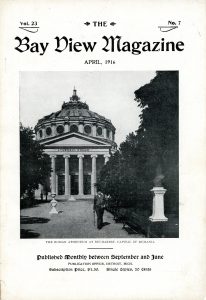A National Reading Club Comes to Geneva
By Becky Chapin, Archivist
In 1875, Michigan Methodists met in Jackson to organize a camp meeting. They chose Bay View, Michigan as the site because of its climate and availability by railroad and steamer. The next year, several hundred people arrived for six days of religious talks and sermons. The event grew year by year until the area had been developed into cottages, a hotel, and a chapel.
A religious program expanded from six days to eight weeks during the summer, while interest in literary and scientific groups grew. In 1893, founder John M. Hall launched the Bay View Reading Circle. His program was based on the study of art, culture, history, and language of one European country per year. He began publishing the Bay View Reading Magazine and lists of various approved textbooks.
Bay View also established an adult education institution, named Chautauqua after the county in New York where the first gatherings of education and entertainment were held.
According to a marker in Bay View, membership to the reading circle “provided educational enrichment and a collegiate atmosphere at a modest price.” Students who completed four years of study and completed the examinations at the end were awarded an ornate diploma.
In 1908, Jane Lanning visited the Newark Reading Circle and was inspired to start a branch in Geneva. In September, a group of eleven women held their first meeting to begin the organization of the Bay View Reading Club (later Study Club) in Geneva. The club was limited to twenty members or less, with about seventeen signing up for the first year.
Their first course would focus on Italy and Greece, following the program offered in the Bay View Reading Magazine. Each member paid ten cents into the contribution fund and took turns hosting meetings at their home.
To start each meeting, the hostess would do roll call. Members would respond differently each week. One week, members responded with prose gems, another with miscellaneous quotations, and another with descriptions of famous pictures and a fact about the painter. This roll call and response would continue throughout the club’s existence.
The club followed the Bay View Magazine programs for several years after its organization until the magazine was discontinued. Later, a program chairman was appointed and outlined a program for the year’s activities. It’s unclear when the magazine stopped publication, but its editor and publisher John M. Hall passed away in December 1914 in Detroit after contracting pneumonia.
His passing was significant enough that his obituary was published in the Geneva Daily Times in January 1915. Apparently, Hall was personal acquaintances with several people in Geneva, including his college classmate Frank E. Clark who was living on Elmwood Place.
The Geneva club read and talked about Rome, Spain, and more countries in its first several years. The first program in the Historic Geneva’s Archives is for the 1926-1927 year. Discussions had expanded to women writers, women artists, and women under New York law. Other points of debate were public heath, lack of economy in the American people, why religious observations were decreasing, and a frank discussion on if women’s clubs work was worthwhile.
Into the 1930s, the programs included topics related to Geneva including the local health conditions, civic improvement due to women, our churches, and the social and moral conditions of the city. Like other women’s clubs in Geneva, the group met in special circumstances during wartime to help with Red Cross work.
The study club often hosted the Fortnightly Reading Club, and vice versa. Once the Geneva Historical Society had a museum, the group sometimes met there. The club paid for membership with GHS and a former director, Laura Merritt, was a member of the reading club.
As far as I can tell, the Bay View Study Club ceased meeting after about 1965, though the programs in our collection only go to 1961-1962.
At its height, the national reading club membership peaked at 25,000. In 1987, Bay View received a National Historic Landmark designation by the National Park Service because it is “one of the finest remaining examples of two uniquely American community forms, the Methodist camp meeting and the independent Chautauqua… Bay View is a major example of American religious, cultural, social, and educational ideals embodied in an artistically shaped community plan.”
References:


